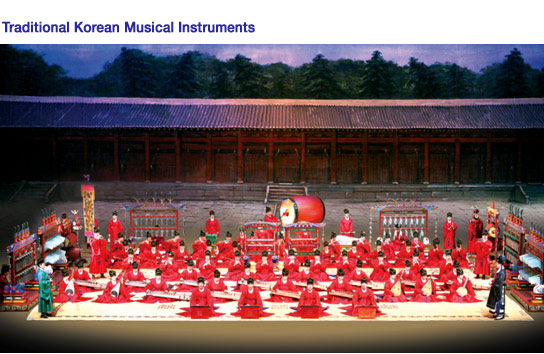aditional Instruments
 |
|
<Jongmyo Jeryeak>
Music is an art form whose beauty largely depends on the instrument or human
voice used to create the sound. No matter how complex or masterfully-composed a
piece is, it remains silent in absent of the voice of an instrument to give it
life. Therefore, understanding musical instruments is, in essence, understanding
and appreciating music.
There are about 60 traditional instruments in Korea. Some have local origins
and date back as far as the 4th century; while others were adapted in Korea
after having been introduced to Korea from the West or China. Though some of
these instruments have not stood the test of time, others have only increased in
popular throughout the passing years. In fact, there are 20 or so traditional
instruments still widely used today.
Korean traditional instruments are
made using locally available materials and are said to be merely carriers of the
sound naturally produced by their materials. A text written in 1903 classifies
Korean traditional musical instruments into eight groups based their materials:
metal, string, bamboo, animal skin, wood, clay, gourd, and stone. Today,
instruments are classified by the same system used in the west, i.e. according
to how the sound is produced. Based on this system, traditional instruments are
divided into wind, string, and percussion categories. |
| |
 |
|
《Gullyeak》
|
《Yeollyeak》
|
《Nongak》
|
|
Korean traditional instruments can also be categorized according to the
genre, which is generally defined by the occasion at which the music is
performed/the instrument is used. Although there are many types of traditional
Korean music under this system, Korean traditional music can be largely divided
into the main groups of court music and folk music. Court music is, according to
the type of ceremony, subdivided into Jeryeak (royal ancestral ritual
music) and Gullyeak (music used in military ceremonies).
In
the folk music category, the genre called nongak refers to the farmers
band music performed with percussion and wind instruments. Also called
pungmullori (풍물놀이), it is a comprehensive art that combines singing,
dancing, and acrobatics. This later became samullori (사물놀이) (featuring
four performers, each playing kkwaenggwari, jing,
janggu, or buk), a modern adaptation of pungmul for
staged performances.
If you want to learn a Korean traditional instrument, check out the classes
run by the National Center for Korean Traditional Performing Arts. Open to
foreigners living in Korea, the classes are held on Saturdays, giving foreigners
working or studying in Korea a great opportunity to appreciate traditional
Korean culture and music through hands-on exploration. |
| |
|
2010 Korean Musical Instrument Class
for Foreigners
|
Period
|
1st Semester: Mar. 6 – May 22, 2010 (12 weeks), every Saturday
10:30-12:30
2nd Semester: Sep. 4 – Nov. 20, 2010 (12 weeks), every Saturday
10:30-12:30
Price: 30,000 won for 12 weeks |
|
Place
|
National Center for Korean Traditional Performing Arts, Korean Music Training
Institute |
|
Participants
|
Class limit: 20 foreigners (4 classes, 160 people throughout the year)
|
|
Programs
|
Janggu, gayageum, haegeum, samullori classes
- Prerequisite for samullori
class: must have taken janggu class before or be able to play janggu
|
|
To apply
|
Download the application form at the website below and send it by E-mail
(first-come, first-served).
Official site: www.gugak.go.kr (Korean, English)
Send
application form to baewon76@gmail.com
|
|
Tel
|
02-580-3054 |
* Classes are subject to change due to any
unforeseeable circumstances.
|
|
| |
☞ Related
columns
- Traditional Korean Music
- The Pansori Epic Chant
- The Royal Ancestral Ritual in the Jongmyo
Shrine and its Music
* Photo and text courtesy of
the National Center for Korean Traditional Performing Arts |


댓글 없음:
댓글 쓰기